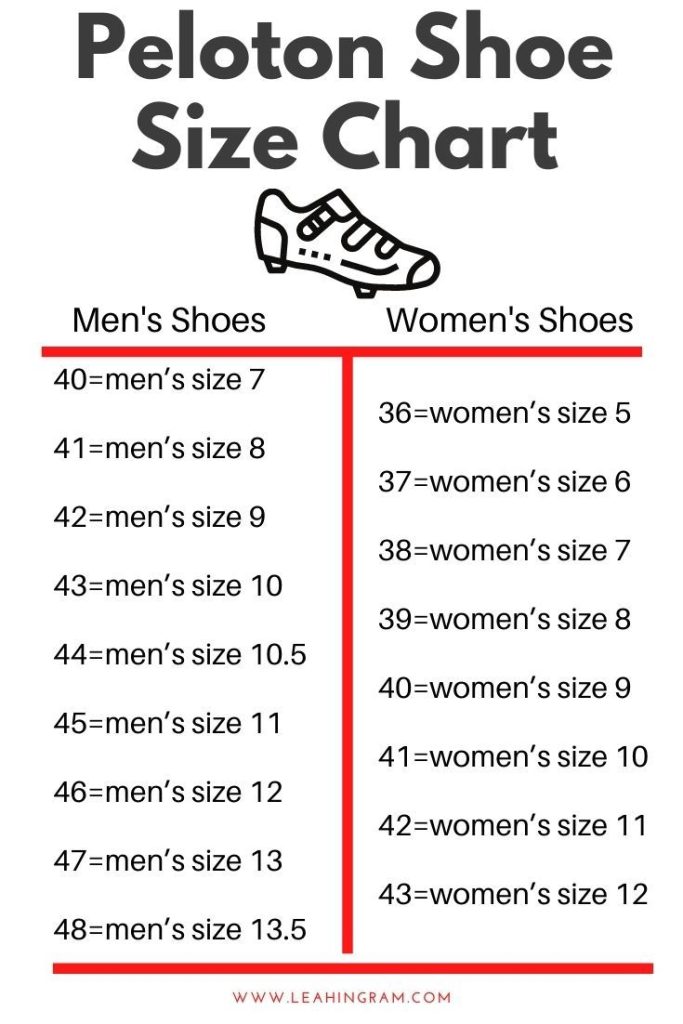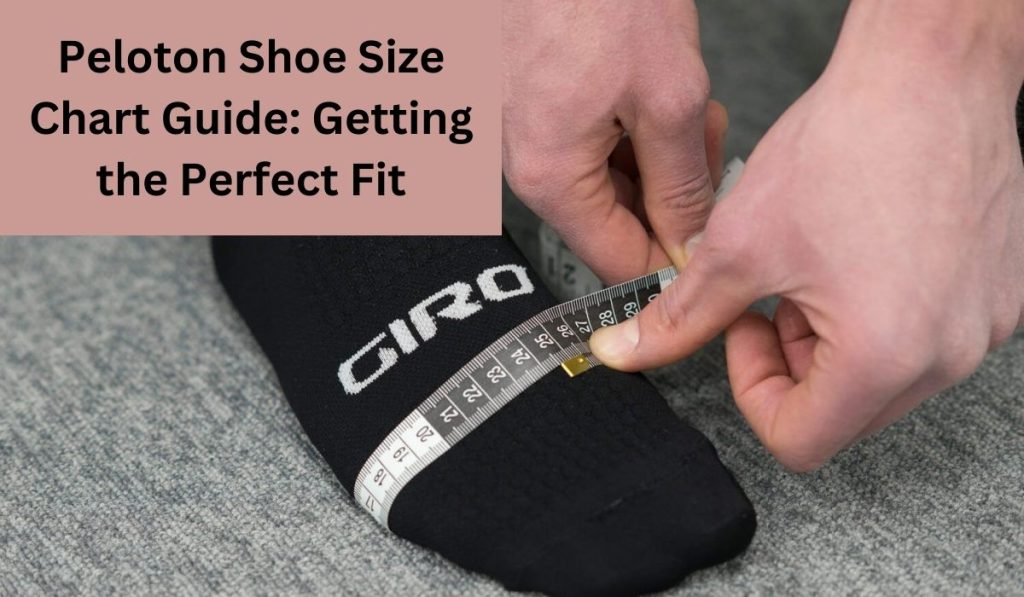Alright, fellow Peloton enthusiasts let’s talk shoes! If you’ve jumped on the Peloton bandwagon (or bike, in this case), you know how essential those cycling shoes are. A snug shoe doesn’t just add to our workout’s oomph; it’s the difference between gliding through a session and huffing through with aching feet. Let’s decode that Peloton shoe size chart together, shall we?
Why the Right Peloton Shoe Size is a Game Changer?
Power Up
Think of your shoe as the middleman between your foot and the pedal. The better the fit, the better the power transfer. A shoe that molds to your foot ensures that every ounce of effort you put in is efficiently channeled into the bike. No energy wastage, just pure performance.
All About the Feels
Ever walked a mile in uncomfortable shoes? Then you know the drill. A cycling shoe that’s too tight or too loose can become a source of constant distraction. Proper fit means no pinching, no slipping, and no premature fatigue. It’s all about riding in harmony with your bike.
Stay Safe
Safety isn’t just about avoiding falls; it’s about ensuring that every part of your workout routine, including your attire, works with you and not against you. A shoe that doesn’t fit can lead to slips or imbalance, and we don’t want that mid-session!

What’s What?
Heads up! This is a ballpark guide. Brands and models can throw a curveball, so always check specifics.
| US Size | EU Size | UK Size | CM (Foot Length) |
|---|---|---|---|
| 5 | 36 | 3 | 22 |
| 6 | 37 | 4 | 23 |
| 7 | 38 | 5 | 24 |
| 8 | 39 | 6 | 25 |
| 9 | 40 | 7 | 26 |
| 10 | 41 | 8 | 27 |
| 11 | 42 | 9 | 28 |
| 12 | 43 | 10 | 29 |
| 13 | 44 | 11 | 30 |
Peloton Shoe Size for Women’s Shoe Size and Men’s Shoe Size
| US Size | EU Size | UK Size | Women’s Shoe Size | Men’s Shoe Size |
|---|---|---|---|---|
| 5 | 36 | 3 | 5 | |
| 6 | 37 | 4 | 6 | |
| 7 | 38 | 5 | 7 | 6 |
| 8 | 39 | 6 | 8 | 7 |
| 9 | 40 | 7 | 9 | 8 |
| 10 | 41 | 8 | 10 | 9 |
| 11 | 42 | 9 | 11 | 10 |
| 12 | 43 | 10 | 11 |
Always consult with a professional or the official Peloton guide before making a purchase.
According to a study by the ScienceDirect, a well-fitted cycling shoe can improve a rider’s efficiency by up to 15%. This shows the importance of having the right shoe size, especially for Peloton users aiming to optimize their workouts.
Nailing that Perfect Size
DIY Foot Measuring
The best way to get an accurate foot measurement is in the evening when your foot is at its largest (yep, feet swell during the day). Place your foot flat on paper, trace around it, and measure. This gives you a more accurate reflection of your foot’s size under workout conditions.
Wide Foot? No Problem!
Peloton shoes might not cater to everyone’s width. But the shoe world is vast. Brands like Shimano and Sidi offer wider options. So, if Peloton doesn’t fit right, explore until you find your match.
Sock It Right
Socks can be sneaky! The thickness of your sock can change the fit of your shoe. Planning to wear thicker winter socks? They might just be the reason you need to size up. “Finding the perfect fit for both your shoes and socks is key, especially for those who spend a lot of time on their feet. It’s not just about size, but how all the elements work together to support you through your workout,” says Nate Banks, a fashion expert at Crazy Compression.
When considering fashion and comfort, custom socks can be an important part of your overall look. First, Custom Socks allows you to choose colors and patterns according to your personal preferences, matching your clothing style and enhancing your fashion sense. Second, custom socks can be designed based on your foot shape and size to ensure the best fit and comfort, which is especially important for people who stand or walk for long periods.
In addition, custom socks can be selected for special functions based on your activity needs, such as moisture-wicking, anti-bacterial and odor-resistant, or providing extra foot support. These features can improve the wearing experience. By working with a designer, you can ensure that the socks are not only beautiful but also practical, meeting your needs in different situations. Whether for everyday wear or special events, custom socks can show your personality and taste while ensuring the best care for your feet.

Goldilocks Zone
The ideal shoe hugs your foot, supports your arch, and gives your toes wiggle room. Too tight, and you’re looking at possible circulation issues. Too loose, and your foot will move around, reducing your pedaling efficiency.
Undecided? Size Up!
Always err on the side of caution. A slightly bigger shoe offers room for insoles or thicker socks. A smaller shoe, on the other hand, is just a recipe for discomfort.
Friendly Tip
Always, always check return policies. Especially when buying online. It gives you the freedom to return or exchange without fuss if the shoe doesn’t feel right.
Testimonials
“After decoding the Peloton shoe size chart, I can vouch for its accuracy. The difference a properly fitted shoe makes is night and day. No more sore feet after sessions!” — Alexa M., Long-term Peloton User and Certified Cycling Trainer.
“When it comes to power transfer and overall cycling efficiency, nothing beats a well-fitted shoe. I’ve seen countless cyclists improve their performance simply by ensuring their shoes fit correctly.” — Dr. Jonathan K., Sports Scientist & Cycling Coach
Wrapping it Up:
Alright, pedal-pushers, now that we’ve cracked the code, here’s to hoping your next ride feels less like a shoe gamble and more like a glide. Remember, when in doubt, size up, and happy cycling!
Frequently Asked Questions (FAQs) about Cycling Shoes
Q1: Can I use regular athletic shoes with my Peloton bike?
While it’s possible to use regular athletic shoes with toe cages on a Peloton bike, for optimal power transfer and a better cycling experience, it’s recommended to use specific clip-in cycling shoes that are compatible with the bike’s pedals.
Q2: How often should I replace my cycling shoes?
Generally, good quality cycling shoes can last anywhere from 2 to 5 years, depending on usage and care. If you notice reduced performance, discomfort, or visible wear and tear, it’s time for a replacement.
Q3: What’s the difference between road and indoor cycling shoes?
Road cycling shoes are designed primarily for outdoor cycling. They usually have a stiff sole and can be less comfortable for walking. Indoor cycling shoes, on the other hand, are tailored for stationary bikes like Peloton and often have a slightly more flexible sole and may be more comfortable for off-bike activities.
Q4: Are Peloton shoes compatible with other stationary bikes?
Peloton shoes use a Look Delta cleat system. If the other stationary bikes have pedals compatible with this system, then yes. Otherwise, you might need to either replace the pedals or use different shoes.
Q5: Can I use cycling shoes with other types of cleats on my Peloton bike?
The Peloton bike is designed for Look Delta cleats. If you have shoes with different cleat systems, like SPD, you’ll need to swap out the pedals or use a converter to ensure compatibility.
Q6: What size is 41 in Peloton shoes?
A size 41 in Peloton shoes typically corresponds to a men’s US size 8 or a women’s US size 10. Peloton shoes follow European sizing, so size 41 is often recommended for those who wear these US sizes. It’s always a good idea to check Peloton’s sizing chart for accurate fitting.
Q7: What size is 42 in shoes?
A size 42 in shoes typically corresponds to a men’s US size 9 or a women’s US size 11. Shoe sizing can vary slightly by brand, so it’s recommended to refer to the specific brand’s size chart for the most accurate fit.
Q8: How does Peloton shoe sizing work?
Peloton shoes use European sizing, with a common size range from 36 to 48. For conversions, a size 39 typically fits a women’s US size 8, while a size 42 corresponds to a men’s US size 9. Peloton recommends checking their size chart and considering a snug fit for optimal performance during rides.

